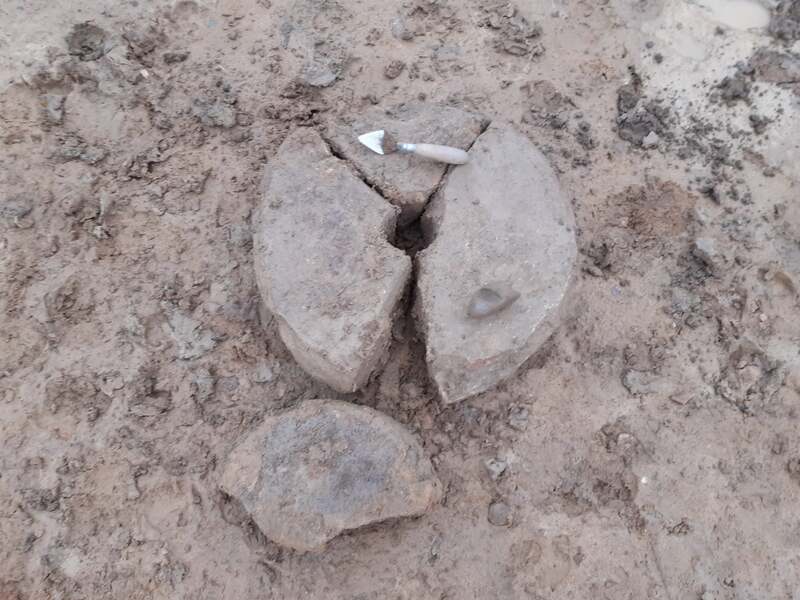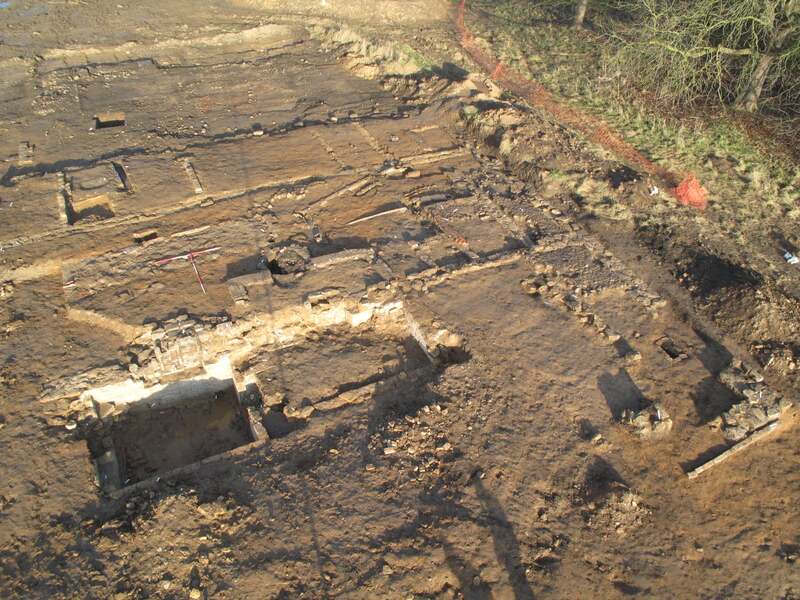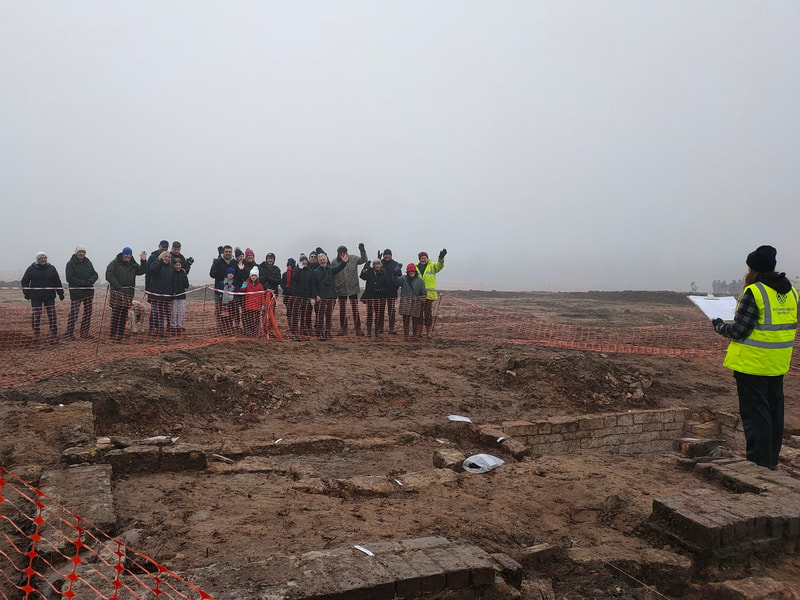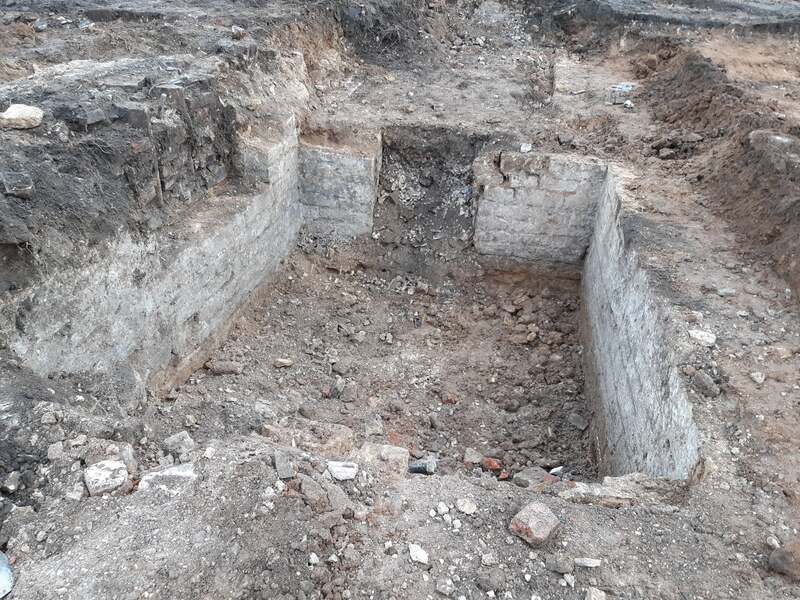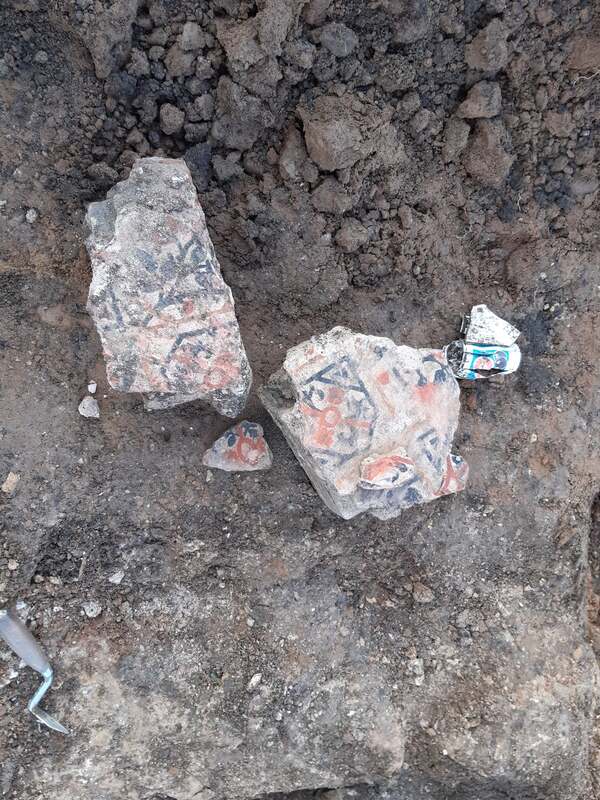Swinnow Hall excavation - site visit:
Over 100 people applied to visit the archaeological excavations being undertaken by the West Yorkshire Archaeological Service on Saturday, 15 January, and were guided around the site in several groups (see photos below). The Open Day was arranged in conjunction with and publicised by Wetherby Civic Society, a member of Better Wetherby. The excavations were taking place on the land off Racecourse Approach on sites which had been previously during a survey undertaken for Taylor Wimpey as part of the requirements to build 800 houses on the wider site.
On one part of the dig, a Romano-British enclosure had been identified. The perimeter of this enclosure consisted of a rectangular ditch with an earth bank supported by boulders.
Initially, the archaeologists were unsure as to whether this was just an enclosure for keeping cattle overnight or a farmstead. The finding of a broken quern, used for grinding corn, (see photo) in the ditch confirmed that people must have lived at the site. Post holes for an entrance into the enclosure were found as were fragments of everyday Roman period pottery.
The other excavation revealed the foundations of Swinnow Hall, a significant building which is shown on maps before 1770, but appears to have been destroyed in the 1890s, by which time it had been bought by the owners of Ingmanthorpe Hall. The ha-ha, a ditch to keep animals out, surrounding its garden had been uncovered in an earlier excavation. The work revealed extensive remains including a cellar. Finds included the painted plasterwork from the rooms above, which had fallen into the cellar during the demolition. The reasons for its destruction are at present unknown, but may have been to allow the extension of the drive from the York Road to be extended to provide an entrance to Ingmanthorpe Hall. Plans are in hand for Wetherby Civic Society to work with the Archaeological Service to research the archives to find out more about this little known mansion.
Taylor Wimpey plan to build houses over both of these sites, but the Civic Society and Better Wetherby ars asking that a proposed adjoining grassed area be extended to cover the Hall, and its footprint be displayed by paths of gravel and a suitable display board.
Further photos, finds and other information can be seen on Facebook at https://www.facebook.com/aswyas1.
Over 100 people applied to visit the archaeological excavations being undertaken by the West Yorkshire Archaeological Service on Saturday, 15 January, and were guided around the site in several groups (see photos below). The Open Day was arranged in conjunction with and publicised by Wetherby Civic Society, a member of Better Wetherby. The excavations were taking place on the land off Racecourse Approach on sites which had been previously during a survey undertaken for Taylor Wimpey as part of the requirements to build 800 houses on the wider site.
On one part of the dig, a Romano-British enclosure had been identified. The perimeter of this enclosure consisted of a rectangular ditch with an earth bank supported by boulders.
Initially, the archaeologists were unsure as to whether this was just an enclosure for keeping cattle overnight or a farmstead. The finding of a broken quern, used for grinding corn, (see photo) in the ditch confirmed that people must have lived at the site. Post holes for an entrance into the enclosure were found as were fragments of everyday Roman period pottery.
The other excavation revealed the foundations of Swinnow Hall, a significant building which is shown on maps before 1770, but appears to have been destroyed in the 1890s, by which time it had been bought by the owners of Ingmanthorpe Hall. The ha-ha, a ditch to keep animals out, surrounding its garden had been uncovered in an earlier excavation. The work revealed extensive remains including a cellar. Finds included the painted plasterwork from the rooms above, which had fallen into the cellar during the demolition. The reasons for its destruction are at present unknown, but may have been to allow the extension of the drive from the York Road to be extended to provide an entrance to Ingmanthorpe Hall. Plans are in hand for Wetherby Civic Society to work with the Archaeological Service to research the archives to find out more about this little known mansion.
Taylor Wimpey plan to build houses over both of these sites, but the Civic Society and Better Wetherby ars asking that a proposed adjoining grassed area be extended to cover the Hall, and its footprint be displayed by paths of gravel and a suitable display board.
Further photos, finds and other information can be seen on Facebook at https://www.facebook.com/aswyas1.
Photos above courtesy of ASWYAS and Better Wetherby
Click here for further details of the proposed development
Click here for further details of the proposed development
Better Wetherby, and the Wetherby Civic Society, have been liaising closely with Taylor Wimpey to ensure that a comprehensive program of archaeological investigation is performed on this site.
We visited the site in mid December to view progress on the "final" phase of excavations, where we viewed a Romano-British enclosure and some of the foundations of Swinnow Hall, a large Georgian mansion which was demolished in the 1890s. The day prior to our visit they had uncovered a previously unknown cellar with a bricked up window; other finds include Roman pottery, a few coins and a quantity of decorated plaster from the Hall. Pictures from this visit can be seen on the Wetherby Civic Society FB page (https://www.facebook.com/WetherbyCivicSociety)
More recent finds have included a Roman quern stone, and can be viewed on the ASWYAS page at https://www.facebook.com/aswyas1.
ASWYAS are planning to hold an open day for the Swinnow Park site on Saturday the 15th of January. By this time they are hoping to have all the remains of the hall cleaned up ready to be viewed, and also should have other artifacts on display from the site.

